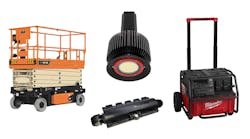TEC Electric, Inc., a Darlington, Pa.-based commercial electrical contractor, recently faced completing the electrical contract on a 16-week medical arts building project while the lead time for luminaires dragged out 12 weeks. Toward the end of the schedule, the job was mostly finished, yet 160 luminaires were still on back order. “Everybody else had their work done, and I looked like a fool,” says Joel Freson, estimator and project manager for TEC Electric. “The project manager was calling daily, asking ‘Where are these light fixtures?’ Well, I ordered them 12 weeks ago!”
According to Freson, the project wasn’t even a particularly large job. “It was a decent order but not huge,” he explains. However, on all recent jobs, lead times that used to span three to five weeks have now lengthened to 10 or 12 weeks. “Every job has long lead times for the light fixtures now,” says Freson.
Complicating matters is the common practice of fast-tracking jobs. “On any job, it seems they want to fast-track the schedule,” says Freson, who more recently took on a 12-week fast-tracked job, only to learn that the lead time for the luminaires would also be 12 weeks. “With everybody wanting to fast-track jobs now, longer lead times are a big issue.”
Fortunately for TEC Electric, non-lighting-related delays pushed the entire job back. “If there hadn’t been the delays, I would have really been in trouble,” Freson admits.
Bad timing. In June 2010, Northeast Electrical Distributors, Brockton, Mass., was among the first to report longer lead times for electronic ballasts from all major manufacturers. Lead times, according to the electrical distributor’s advisory, were being extended by 50% or, in some cases, double their average time throughout the summer, which is often the busiest time of the year for luminaire sales. “This will cause significant delays in fixture delivery dates and will surely disrupt project scheduling and deadlines,” read the company’s bulletin.
Initially, distributors and manufacturers were expecting the longer lead times to last only a few months. This projection was then revised to the end of the year. Now, they are forecast to continue into 2011. As a result, many manufacturers have discontinued their “quick-ship” programs altogether.
Adding to the demand for electronic ballasts, in July 2010, the federal efficiency standards regulating fluorescent magnetic T12 ballasts entered their final phase, which, with only a few exceptions, basically takes these ballasts off the market. As of July 1, 2010, ballast manufacturers were prohibited from manufacturing magnetic ballasts. Stock purchased by dealers prior to the cutoff date can still be sold until inventory runs out or up to five years after July 1, 2010.
Although new construction has already transitioned to the electronic ballasts, without magnetic ballast replacements on the market, many buildings will soon be forced to take on extensive lighting retrofit projects. According to the National Electrical Manufacturers Association (NEMA), Rosslyn, Va., about 7% of the ballast market comprised magnetic ballasts.
“None of the manufacturers can tell us what they’re anticipating,” says Kyle Hanson, VP of project sales, ConneXion, a Chicago-based electrical distributor that keeps its customers updated on ballast lead times at http://www.connexiones.com/lighting-ballast-shortage. “Six months ago, we were told by the end of the year it would be cleaned up, but that has not happened.”
However, according to Hanson, lead times that were reaching anywhere between eight to 12 weeks have now been reduced to between six and eight weeks. “It has gotten much better,” he says. “These are more reasonable lead times.”
Yet, because the ballast manufacturers work from a lean inventory, or a “just-in-time” process, they sometimes miss the anticipated ship date without much warning. “We don’t find out until a day or two before — or sometimes even the day of — that the fixtures aren’t going to ship,” Hanson says. “So even though we’ve called numerous times to make sure it’s still on schedule, and their system shows that they’re on schedule, not until the day that it’s supposed to ship do we find it’s back ordered. The manufacturers are not very proactive in managing this process.”
Furthermore, this just-in-time approach can make accommodating customer changes especially difficult, if not impossible, says Freson. “If the clients make a change, say they want to add on to a room so you need six more light fixtures, then you have to tell them it’s going to be eight to 10 weeks,” he says. “They just look at you like you’re crazy.”
Jelly beans
The longer lead times are due to a worldwide shortage of electronic components, including capacitors and integrated circuits, used not only in ballasts but also flat-panel video screens and smart phone displays, according to an item in the July 23 issue of Electrical Marketing. When the recession hit, some of the manufacturers of these capacitors went out of business, while others ramped down production, producing only enough to supply mainly the major manufacturers of consumer electronics and telecommunications equipment instead of their smaller customers, the manufacturers of electronic lighting ballasts.
As a result of the components shortage, electronic ballast makers are suffering through their own extended lead times (up to 20 weeks in some cases), according to market research firm iSuppli, El Segundo, Calif. In comparison, normal lead times for such components typically run approximately 10 to 12 weeks.
The components shortage is also causing an increase in the average selling prices for the components, according to iSuppli, which is predicting the rise in prices to continue throughout 2011. How this will affect ballast prices is a matter of speculation.
As of right now, all major luminaire manufacturers have announced price increases from 5% to 7%, which are set to go into effect anywhere from the end of February to the end of April.
Nevertheless, many in the industry aren’t blaming the ballast shortage for that. “I think that’s a legitimate raise,” says Hanson. “I don’t believe it’s related to the shortage.”
Instead, the increases seem to be a result of the rising costs of raw materials. “Wire keeps going up,” Hanson notes. “Steel keeps going up. That affects all those components in fixtures and raises the cost of manufacturing.”
The ballast manufacturers aren’t in a position to raise prices because of the shortage, according to Hanson. “I have not seen the manufacturers using the ballast shortage as a way to make more money,” he says. “It’s too competitive of an environment right now. With the market being somewhat condensed, none of them can afford the risk. I’m not seeing any true inflation.”
Because of the extended lead times and higher prices for components, Joerg Schulze-Clewing, a consultant based in Cameron Park, Calif., encourages manufacturers to use “jelly bean” parts, which he describes as components that can be bought for pennies from half a dozen manufacturers. “Manufacturers shouldn’t use any fancy new parts unless they absolutely have to,” he says. “It’s better to use parts where there are numerous second sources — and to avoid parts from manufacturers that are known to prefer key accounts.”
The component shortage can be solved through more accommodating product design, says Schulze-Clewing. “One way to accomplish this is to make the component tolerances in the circuit as large as possible,” he says. “This alone can save the day in many allocation situations that might arise later. Before I use any specialty chip, there had better be a really good reason. Convenience is not a good reason.”
This advice can carry over to electrical design as well. If the engineer has included fluorescent luminaires with specified ballast suffixes, then the electrical contractor may want to suggest substituting them for fixtures that use generic ballast suffixes. That way, the manufacturer can work with one of a few ballast vendors instead of being limited to one model from one specific vendor that may be overrun with orders. “There aren’t longer lead times on a private job where they’re asking you to provide a generic light fixture,” Freson says. “There are plenty of those available.”
Squeaky wheels
At first, the components shortage affected mostly standard T5 output ballasts. Last summer, however, it spread to high-output T5 and T8 ballasts. But, of all the electronic ballasts, program rapid start ballasts have been affected most by the components shortage. “Due to the energy codes and use of occupancy sensors and lighting controls, the ballasts that are going into these fixtures are a different type of technology from what they have used in the past,” says Hanson. “To get the correct lamp light, you’ve got to use a program rapid start ballast, and they have the biggest issue with lead times.”
To avoid missed deadlines, electrical contractors may need to consider substitutions. “If you’ve got X manufacturer that can’t move the ship date for you, most of those products have a similar product made by somebody else,” Hanson says. “So certainly you can cross it over if you can get a commitment that the other manufacturer can ship by your date.”
Substituting alternative technologies can also be a smart strategy for avoiding longer lead times. For example, instant-start ballasts are one option. “If the engineer has specified program rapid start everywhere, but there’s only 20% of fixtures on the job that are actually controlled by sensors, then it might make sense to switch those to instant start,” says Hanson. “Instant start are more readily available.”
In addition, dimmers for linear fluorescent lamps can be used instead of on-off switching. But unfortunately, some industry professionals are predicting longer lead times on some of these alternative technologies, such as HID and compact fluorescent ballasts, as well as LED drivers and some lighting control products. The component shortage is not exclusive to lighting ballast manufacturers, according to ConneXion, which reports being forewarned to expect long delays with certain occupancy sensor and dimmer products. “You can bet that there will be a wide impact across all finished goods manufacturing,” warns the electrical distributor. “The electrical industry is just now feeling the effects of what the consumer electronics industry has been forecasting and dealing with since last year.”
Therefore, if the design mandates that you must use luminaires plagued by long lead times, there are some strategies you can employ to cut down the waiting time and work cooperatively with distributors and manufacturers (Proactive Measures).
Both manufacturers and distributors advise releasing orders immediately. That way, your order will be placed into the manufacturer’s queue in a timely manner. A “do-not-ship-before-date” instruction can be attached to the order to prevent premature delivery on the work site. This should be done even on orders for luminaires that are generally available on short notice. “It is critical that orders be released as early as possible,” says Hanson, emphasizing that ordering fixtures for fast-track projects should never be delayed. “Jobs that have quick occupancy and fast turnover deadlines will be the most difficult to complete.”
Beyond simply releasing the order as early as possible, you can also ask for a pre-negotiated delivery schedule. If you know an upcoming job has a tight schedule and you’ll need luminaires, you should schedule a meeting with the distributor and the manufacturer ahead of time and attempt to contract a pre-negotiation. “This will allow the manufacturer to look at its resources and give us a commitment letter that they will ship by a certain date,” explains Hanson. “I would say that 95% of the time, when you get a commitment letter, the manufacturer holds up its end of the bargain and ships on time.”
This is in contrast to the normal process, according to Hanson, where the electrical firm releases the order and then begins to try to expedite it — in essence playing catch up. “At that point, you have much less control,” Hanson says. “In pre-negotiations, you’re basically telling the manufacturer that you’re not going to release the order unless it can commit to shipping the product by the date you need it. Manufacturers will typically give you the commitment, because they don’t want to lose the order. You’re more likely to get a better result that way.”
In the absence of a pre-negotiated commitment, it’s your job, in concert with the distributor, to remain proactive. The squeaky wheel gets the grease, according to Hanson. “You gotta continually hound them,” he says. “Send e-mails and make phone calls. Try to run up the ladder as high as you can to get the products you need.”




